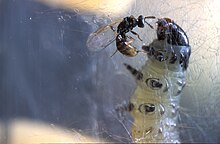Eulophidae
| Eulophidae | |
|---|---|
 | |
Colpoclypeus florus | |
Scientific classification | |
| Kingdom: | Animalia |
| Phylum: | Euarthropoda |
| Class: | Insecta |
| Order: | Hymenoptera |
| Superfamily: | Chalcidoidea |
| Family: | Eulophidae Westwood 1829 |
| Subfamilies | |
Elasminae | |
Diversity | |
Five subfamilies about 300 genera about 4300 species | |
Wikispecies has information related to Eulophidae |
The Eulophidae are a large family of hymenopteran insects, with over 4,300 described species in some 300 genera. The family includes the genus Elasmus, which used to be treated as a separate family, "Elasmidae", and is now treated as a subfamily of Eulophidae. These minute insects are challenging to study, as they deteriorate rapidly after death unless extreme care is taken (e.g., preservation in ethanol), making identification of most museum specimens difficult. The larvae of a very few species feed on plants, but the majority are primary parasitoids on a huge range of arthropods at all stages of development. They are exceptional in that they are one of two hymenopteran families with some species that are known to parasitize Thysanoptera. Eulophids are found throughout the world in virtually all habitats (one is even aquatic, parasitising psephenid beetles).
Eulophids are separable from most other Chalcidoidea by the possession of only four tarsomeres on each leg, a small, straight protibial spur (as opposed to the larger, curved one in most other chalcidoids), and by antennae with two to four funicle segments and at most 10 antennomeres.
See also
- Aprostocetus
External links
- Neotropical Eulophidae
- Key to Nearctic eulophid genera
- Family Eulophidae description
- Fauna Europaea
- Nomina Insecta Nearctica
Ponent Spanish. Images.
Universal Chalcidoidea Database on the UF / IFAS Featured Creatures web site
Cirrospilus ingenuus, a citrus leafminer parasitoid
Diglyphus spp., dipteran leafminer parasitoids
Semielacher petiolatus, a citrus leafminer parasitoid